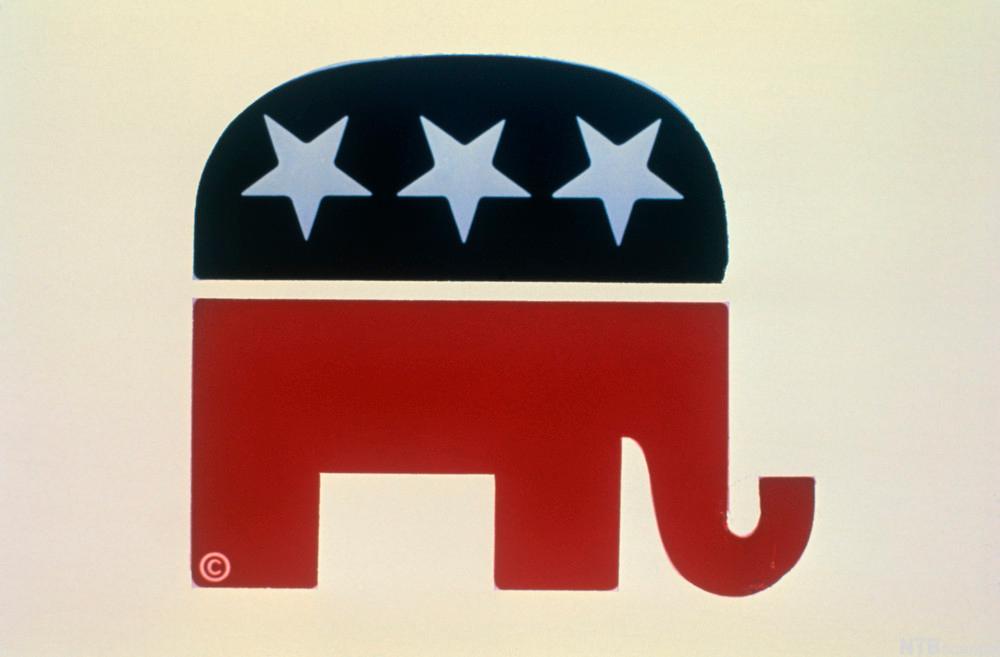
In 1944 Franklin D. Roosevelt from the Democratic Party, won his fourth straight victory with strong support from all the southern states. The states in the South had backed FDR all four times. By contrast, in 2004, the Republican Party won the South. A victory in the South was important for the Republicans because of a major population increase in this region. This has given the Republicans many extra votes in the electoral college.
Electoral College
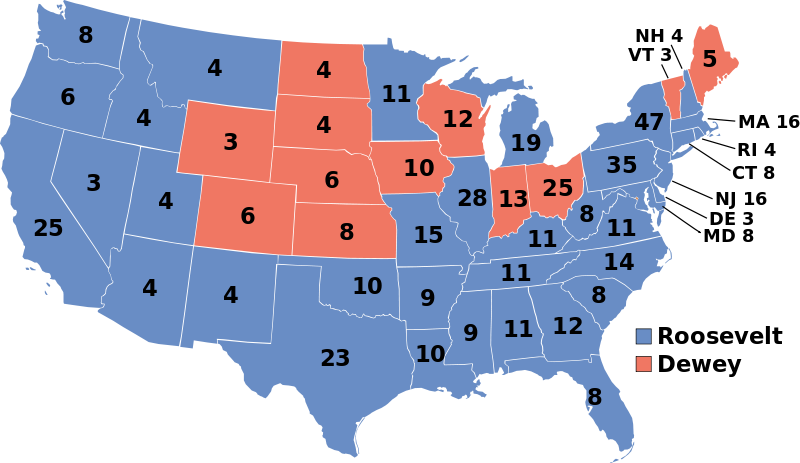
There are 538 votes in the electoral college. This number is based on the 100 seats in the Senate, 435 seats in the House of Representatives, and three votes representing the District of Columbia, which is a federal area and not a state. A presidential candidate needs a majority of the electoral votes to win. Each state has the same number of electoral votes as its number of senators and congressmen combined.
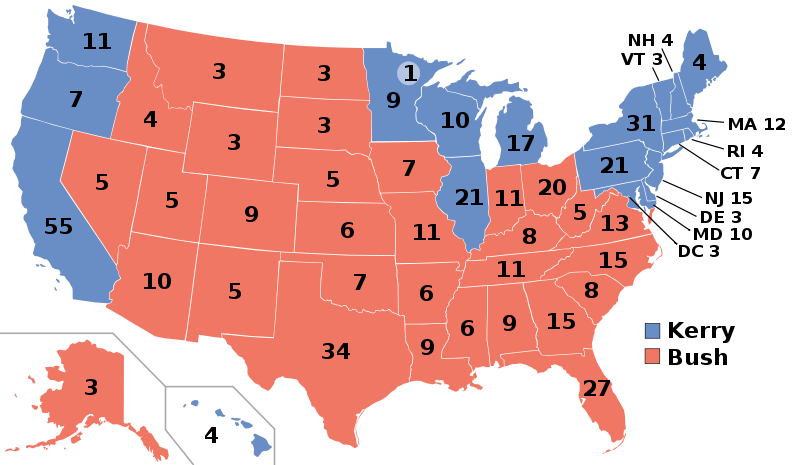
There is a federal census every decade (1990, 2000, 2010 etc) that counts the number of people in the U.S. and where they live. After each census there is a redistribution of seats in the House of Representatives based on population changes. This redistribution directly affects the number of electoral votes each state receives. Florida and Texas are among the big states in the South that have gained many congressional seats and electoral votes since 1944, whereas the states of New York, Pennsylvania and Ohio have lost seats and votes correspondingly because relatively fewer people have moved there and many have left these states and moved to the South and Southwest instead.
Task: Try to find out how many people lived in Florida in 1944 and how many live there now. What about Texas?
There are several reasons why the Democrats lost the South and why the Republican Party and the conservative movement have changed American politics during the last six decades. Lets look at some of them.
Votes against the 1964 Civil Rights Act

African Americans had a very difficult time in the South between the end of Reconstruction (1877) and the 1960s. Many blacks had supported the Republicans because this was the party of Abraham Lincoln, the Civil War president who had freed the blacks. By contrast, the Democratic Party had strong support among the whites. However, in the 1960s, when Presidents Kennedy and Johnson started listening to Martin Luther King and wanted to give civil rights to blacks and end discrimination, many southern whites became angry and decided to support the Republican Party instead. In 1964, Barry Goldwater, a senator from Arizona, became the Republican presidential candidate. He voted against the Civil Rights Act, because he did not think the federal government in Washington had the right to force the states to do what Washington said. Goldwater became popular in the South because of this, even though he lost the election which President Johnson won by a landslide. Johnson correctly predicted that the Democrats would lose the South for a long time because of their support of the Civil Rights Act.
Republicans Strong in the Sunbelt
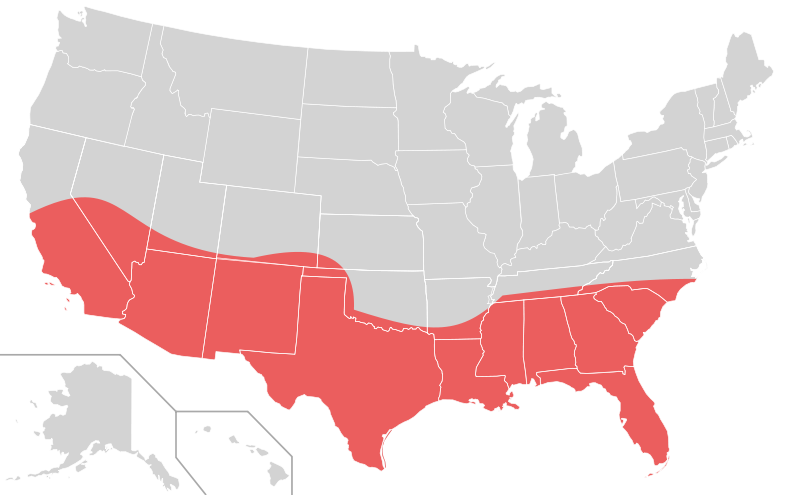
Barry Goldwater represented a geographical shift of the Republican Party from the Northeast and the Midwest to the Sunbelt, a term that refers to the South and the Southwest. Republican Presidents Richard Nixon, Ronald Reagan, George H. W. Bush and George W. Bush have all represented the Sunbelt, where the Republican Party has become very strong and popular after World War II. This part of the United States is the most important area for the military and new high-tech industries. Here, the federal government has created many jobs at military camps and bases and people want to preserve these jobs. Old Testament religious values are particularly strong in the South, with the belief in «an eye for an eye», and this may also serve as an explanation why southerners to a greater extent than other Americans, emphasize the importance of a powerful defense to strike back if others attack first. Thus the Republican Party which favors a strong defense system is an attractive alternative to many people who live in the Sunbelt.
Democrats Divided by the Vietnam War
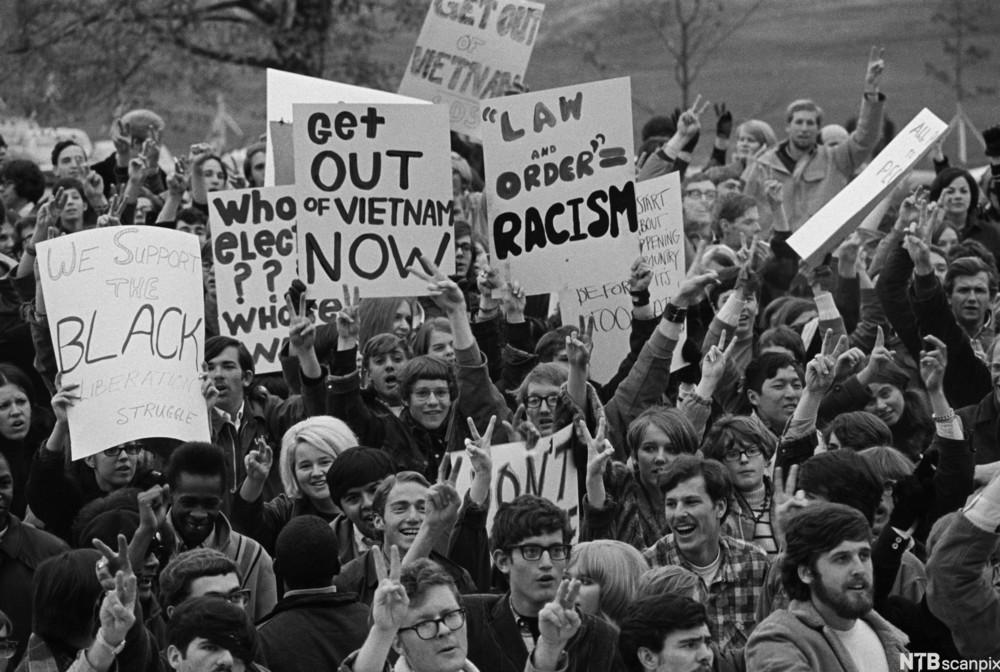
The Vietnam War is an important factor in the development of American political history. In 1968, Lyndon B. Johnson decided not to seek reelection, and the Democratic Party became divided between presidential candidates like Hubert Humphrey, who wanted to continue the war, and Eugene McCarthy, who wanted to end it. Support for the Democrats remained divided in the early 1970s between the working class and the middle class. However, many working class whites still supported the military and thought the war was important to prevent the spreading of communism, and therefore, they disagreed with the 1972 Democratic candidate, George McGovern, who was so strongly against the war. By contrast, a coalition of liberal, white professionals, blacks, and Hispanics, generally opposed the war and wanted to expand anti-poverty programs. McGovern was almost like a Social Democrat and further to the left than earlier Democratic presidents. He even supported the busing of school children to promote integration. He suffered defeat in the 1972 presidential election. Republican President Richard Nixon received the votes of those working-class whites who generally supported the Vietnam War. Nixon had been Eisenhower’s vice-president for eight years in the 1950s and now promised peace with honor in Vietnam.
Nixon: “Law and Order”
Importantly, Nixon also wanted to restore law and order within the United States. Many adults in the U.S., the so called “Silent Majority,” were tired of the 1960s racial riots, hippies, and anti-war protestors, and considered Nixon to be a strong politician who would advocate traditional American values of hard work and patriotism.
A main goal of the Republican Party was to attract working-class white voters, who had supported Franklin D. Roosevelt and Harry Truman, but who did not like a Social Democrat such as McGovern. Slogans such as “law and order” and “patriotism” could help Republicans mobilize new voters and build a new majority coalition (a diverse group of voters, including middle-class whites and working-class whites). Nixon won new white supporters in 1968 and 1972 who had previously supported the Democrats. He did so partly because he opposed busing and advocated tougher police measures against crime and violence.
Business Groups Support Reagan
Many American business leaders in the 1970s were afraid of competition from other nations. They disliked federal government control and wanted more independence. They called this deregulation and said it would make them more competitive. Industrial leaders were disappointed when the environmental protection agency was created in 1973 during the Nixon administration because environmental regulations can make it more difficult for businesses to grow. Business leaders wanted a new president who was more conservative, more positive towards the free market than Presidents Nixon, Ford, and Carter. Therefore, they supported Ronald Reagan in 1980. After he had won, Reagan famously claimed that “government is not the solution to our problems – government is the problem.” This is what business leaders wanted to hear.
In many ways, the main story of American history during the last 40 years has been the mobilization of businesses to weaken labor unions and change the American people’s perception of government. Chief Executive Officers of the largest companies in the United States started cooperating to strengthen businesses and weaken the labor unions. In order to compete with other nations, businesses had to keep wages low. New businesses were established in the Sunbelt where the labor unions had less influence and therefore workers did not have to be paid so much as in the North. Many of the industrial jobs in the northern states had been lost and the textile industry had moved to Asia, therefore, many people moved and hoped to find jobs in the Sunbelt instead, and in Florida, Texas or California, where many IT-companies had their main offices. This, in turn, would give the Sunbelt more power in presidential elections due to the increasing number of electoral votes. This would help the Republicans.
Christians Help Reagan and Bush (Father and Son)

Another factor that would help the Republicans was the rise of the Religious Right in the late 1970s. Many Christians were provoked when the Supreme Court gave women abortion rights in the 1973 Roe v. Wade decision. They felt that abortion was immoral and also that Hollywood values of sexual promiscuity and women’s liberation were threats to traditional family values. Evangelicals fought the force of secularization (absence of God), which they considered to be linked to European socialism and Soviet communism. Christians believed that it was important to preserve American religious values. Republican candidate Ronald Reagan embraced this group in his 1980 presidential campaign. Since 1980, the Religious Right has been very important for the Republican Party in many elections. Opposition to gay marriage was an central issue that helped Bush win reelection in 2004.
Republican Success
The Republican Party has remained strong partly because of cooperation between conservative business groups and religious groups. The coal and oil industries, led by Koch Industries, have been important supporters of the Tea Party movement, which played a significant role in the midterm elections of 2010, when the Democrats lost control of the House of Representatives.
During the last fifty years, the Republican Party has become stronger than it was when Franklin D. Roosevelt and Harry Truman were presidents. One reason is that the Republicans have taken over a majority of the electoral votes in the South from the Democrats. Important effects of Republican victories are lower taxes and deregulation of business. This is great for corporate America.
However, the gap between rich and poor has widened over the last thirty years. Recently, President Barack Obama accused the Republicans of believing in social Darwinism, meaning the survival of the fittest people in a world with less welfare. Social Darwinism is first and foremost associated with the period of the Gilded Age in the late 1800s when there was no federal safety net to help the poor and unfortunate. The Republican Party, led by vice-presidential candidate Paul Ryan, wants to reduce spending on the poor in order to try to balance the budget. Ryan also argues that it is important that Americans take more responsibility for their own lives. He is inspired by the ideas of the author Ayn Rand.